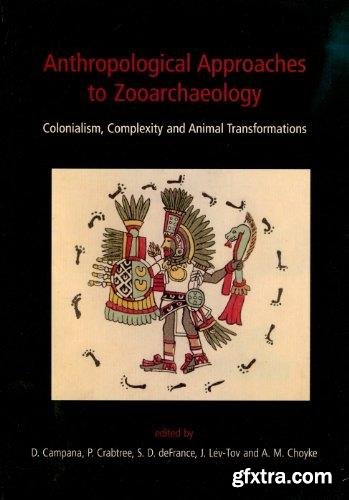
Anthropological Approaches to Zooarchaeology: Colonialism, Complexity and Animal Transformations By Douglas V. Campana (editor), Pamela Crabtree (editor), S. D. deFrance (editor), Justin Lev-Tov (editor), A. M. Choyke (editor)
2010 | 320 Pages | ISBN: 1842173901 | PDF | 38 MB
Animals in complex human societies are often both meal and symbol, related to everyday practice and ritual. People in such societies may be characterized as having unequal access to such resources, or else the meaning of animals may differ for component groups. Here, in this book, 28 peer-reviewed papers that span 4 continents and the Caribbean islands explore in different ways how animals were incorporated into the diets and religions of many unique societies. The temporal range is from the Neolithic to the Spanish colonization of the New World as well as to modern tourist trade in indigenous animal art. The volume explores various themes including the interaction of foodways with complex societies, the interaction between diet and colonialism and the complex role that animals, and parts of animals, play in all human societies as religious, identity markers, or other types of symbols. Organized according to these themes, rather than geographic location or time period, the papers presented here crosscut such divisions. In so doing, this book presents an opportunity for scholars divided by geography especially, but also by temporal period, to explore each other's research and demonstrate that different archaeological settings can address the same problems cross-culturally. Table of Contents Animals and Complexity: How Zooarchaeologists Contribute to the Study of Complex Society in the New and Old Worlds (Justin Lev-Tov and Susan D. deFrance) Part I: Archaeology and Social Complexity 1. A Bird’s Eye View of Ritual at the Cahokia Site (Lucretia S. Kelly) 2. The Organization of Animal Production in an Early Urban Center: The Zooarchaeological Evidence from Early Bronze Age Titris Höyük, Southeastern Turkey (Adam Allentuck and Haskel J. Greenfield) 3. Animal-Derived Artefacts at Two Pre-Columbian Sites in the Ancient Savannas of Central Panama: An Update on their Relevance to Studies of Social Hierarchy and Cultural Attitudes Towards Animals (Richard Cooke and Máximo Jiménez) 4. Body Parts, Placements and People in an Iron Age Town in Bulgaria (Sue Stallibrass) 5. Status and Diet at the Workers’ Town, Giza, Egypt (Richard Redding) 6. Chiefly Fare or Who’s Feeding the Cacique? Equality in Animal Use at the Tibes Ceremonial Center, Puerto Rico (Richard Redding) 7. A Plebeian Perspective on Empire Economies: Faunal Remains from Tel Miqne-Ekron, Israel (Justin Lev-Tov) 8. Continuity and Change in Faunal Consumption Patterns at the Pre-Inka and Inka Site of Yoroma, Bolivia (Jose M. Capriles, Alejandra I. Domic and Sonia Alconini) 9. Living on the Frontier: “Scythian” and “Celtic” Animal Exploitation in Iron Age Northeastern Hungary (László Bartosiewicz and Erika Gál) Part II: Zooarchaeology and Colonialism 10. Archaeozoology and Colonialism: An Introduction (Douglas V. Campana) 11. Craving for Hunger: A Zooarchaeological Study at the the Edge of the Spanish Empire (Mariana E. De Nigris, Paula S. Palombo and María X. Senatore) 12. Zooarchaeology in the Spanish Borderlands of the American Southwest: Challenges and Opportunities (Diane Gifford-Gonzalez) 13. Animal Husbandry at Pimería Alta Missions: El Ganado en el Sudoeste de Norteamérica (Barnet Pavao-Zuckerman) 14. The Adoption and Use of Domestic Animals at Zuni (Carmen Tarcan and Jonathan Driver) 15. “Romanizing” Ancient Carthage: Evidence from Zooarchaeological Remains (Michael MacKinnon) 16. Animal Keeping and Roman Colonization in the Province of Panonia Inferior, Western Hungary (Kyra Lyublyanovics) 17. Zooarchaeology and Colonialism in Roman Britain: Evidence from Icklingham (Pam J. Crabtree) Part III: Animal Transformations 18. The Bone is the Beast: Animal Amulets and Ornaments in Power and Magic (Alice Choyke) 19. Skeletal Manipulations of Dogs at the Bronze Age Site of Százhalombatta-Földvár in Hungary (Maria Vretemark and Sabine Sten) 20. Bovid Skulls in Southeastern European Neolithic Dwellings: The Case of the Subterranean Circular Room at Promachon-Topolnica in the Strymon Valley, Greece (Katerina Trantalidou) 21. Symbolism of Sharks for Fishing-Gatherer Groups from the Sao Paulo Coast, Brazil (Manoel M. B. Gonzalez) 22. Tupilak Transformations: Traditional Ivory Objects as Modern Souvenirs (Bonnie C. Yates and Margaret E. Sims) 23. The Birds and Animals in Ancient Armenian Art (Ninna Manaseryan) 24. The Transformations of the Quetzal Bird (Carmen Aguilera) 25. Pets in pots: Superstitious belief in a Medieval Christian (12th–14th c.) Village in Hungary (Márta Daróczi-Szabó) 26. “Left” is “Right”: The Symbolism behind Side Choice among Ancient Animal Sacrifices (Michael MacKinnon) 27. The Composition and Interpretation of Associated Bone Groups from Wessex (James Morris) 28. Making Themselves at Home: The Archaeology of Commensal Vertebrates (Terry O’Connor)
TO MAC USERS: If RAR password doesn't work, use this archive program:
RAR Expander 0.8.5 Beta 4 and extract password protected files without error.
TO WIN USERS: If RAR password doesn't work, use this archive program:
Latest Winrar and extract password protected files without error.


